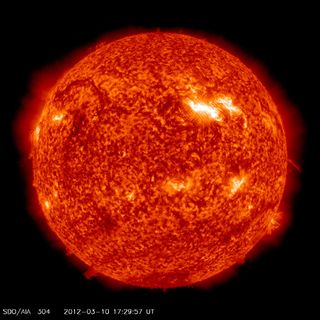
A telescope aboard a prolific sun-watching NASA spacecraft has captured its 100 millionth image of Earth's parent star.
The Atmospheric Imaging Assembly (AIA), one of three instruments flying on the sun-studying Solar Dynamics Observatory (SDO), captured its mind-boggling 100 millionth sun photo on Monday (Jan. 19), NASA officials said.
"Between the AIA and two other instruments on board, the Helioseismic Magnetic Imager and the Extreme Ultraviolet Variability Experiment, SDO sends down a whopping 1.5 terabytes of data a day," NASA officials said in a statement. "AIA is responsible for about half of that. Every day it provides 57,600 detailed images of the sun that show the dance of how solar material sways and sometimes erupts in the solar atmosphere, the corona."

AIA was built at the Lockheed Martin Solar and Astrophysics Laboratory in Palo Alto, California. The instrument consists of four telescopes, which work together to collect eight images of the sun in 10 different wavelengths every 12 seconds.
The $850 million SDO mission launched to Earth orbit in February 2010. It's the first mission in NASA's "Living with a Star" program, which aims to help scientists better understand solar variability and how it affects life on Earth.
SDO's measurements and observations are designed to shed light on how the sun's magnetic field is generated, and how and why this field changes over time. The mission's voluminous data could help scientists get a better handle on space weather, which can affect satellite operations in Earth orbit as well as power infrastructure on the planet's surface.

Solar activity waxes and wanes on an 11-year cycle. The sun is in an active phase of the current cycle, which is known as Solar Cycle 24; the star has blasted out a number of powerful solar flares and superheated clouds of plasma called coronal mass ejections over the past few months.
Get the Space.com Newsletter
Breaking space news, the latest updates on rocket launches, skywatching events and more!
But Solar Cycle 24 has been a quiet one overall, featuring the weakest "solar max" of any cycle in the last century or so, scientists say.
Follow Mike Wall on Twitter @michaeldwall and Google+. Follow us @Spacedotcom, Facebook or Google+. Originally published on Space.com.
Join our Space Forums to keep talking space on the latest missions, night sky and more! And if you have a news tip, correction or comment, let us know at: community@space.com.

Michael Wall is a Senior Space Writer with Space.com and joined the team in 2010. He primarily covers exoplanets, spaceflight and military space, but has been known to dabble in the space art beat. His book about the search for alien life, "Out There," was published on Nov. 13, 2018. Before becoming a science writer, Michael worked as a herpetologist and wildlife biologist. He has a Ph.D. in evolutionary biology from the University of Sydney, Australia, a bachelor's degree from the University of Arizona, and a graduate certificate in science writing from the University of California, Santa Cruz. To find out what his latest project is, you can follow Michael on Twitter.
